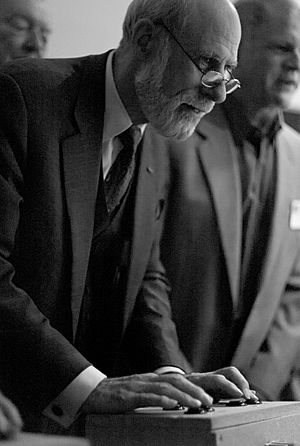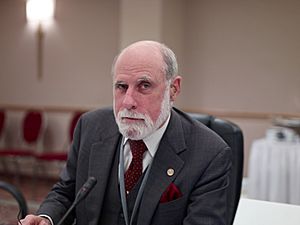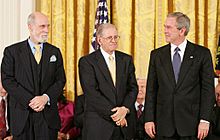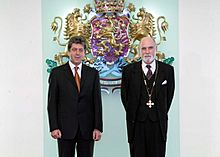Vint Cerf facts for kids
Quick facts for kids
Vinton Cerf
|
|
|---|---|
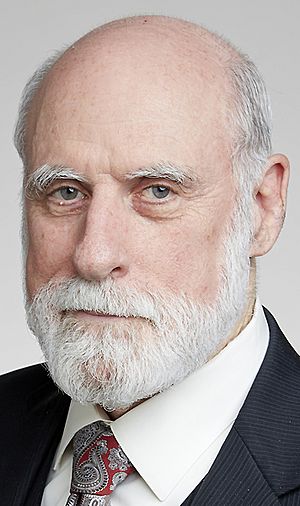
Cerf in 2016
|
|
| Born |
Vinton Gray Cerf
June 23, 1943 New Haven, Connecticut, U.S.
|
| Education | Stanford University (BS) University of California, Los Angeles (MS, PhD) |
| Known for | TCP/IP Internet Society |
| Awards |
|
| Scientific career | |
| Fields | Telecommunications |
| Institutions | IBM, International Institute of Information Technology, Hyderabad, UCLA, Stanford University, DARPA, MCI, CNRI, Google |
| Thesis | Multiprocessors, Semaphores, and a Graph Model of Computation (1972) |
| Doctoral advisor | Gerald Estrin |
| Signature | |
 |
|
Vinton Gray Cerf, born on June 23, 1943, is an American computer scientist. He is known as one of "the fathers of the Internet." He shares this important title with Robert Kahn. Together, they helped create the basic rules for how the Internet works, called TCP/IP.
Cerf has received many special honors and awards. These include the National Medal of Technology, the Turing Award, and the Presidential Medal of Freedom. These awards recognize his huge impact on technology and the Internet.
Contents
Vinton Cerf's Early Life and Education
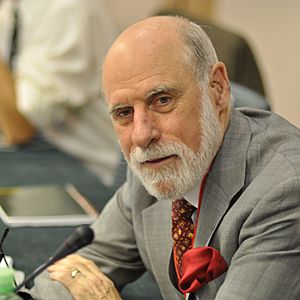
Vinton Gray Cerf was born in New Haven, Connecticut. This was on June 23, 1943. His mother was from Canada. His father's family came from a region called Alsace–Lorraine.
Cerf went to Van Nuys High School. There, he met future Internet pioneers Steve Crocker and Jon Postel. While still in high school, Cerf worked at Rocketdyne. He helped with the Apollo program for six months. He wrote software to check the powerful F-1 engines.
He earned a Bachelor of Science degree in mathematics. This was from Stanford University. After college, Cerf worked at IBM for two years. He was a systems engineer.
Family Life and Accessibility Advocacy
Vinton Cerf and his wife, Sigrid, both have hearing difficulties. They met at a hearing aid office in the 1960s. This experience led Cerf to become a strong supporter of accessibility. This means making technology easier for everyone to use. They have two sons, David and Bennett.
Building the Internet: Cerf's Key Contributions
After IBM, Cerf went to graduate school. He studied at the University of California, Los Angeles (UCLA). He earned his Master's degree in 1970 and his PhD in 1972. At UCLA, he worked on early data packet networks. These networks connected the first parts of the ARPANET. The ARPANET was the very first version of the Internet.
Developing TCP/IP Protocols
While at UCLA, Cerf met Bob Kahn. Kahn was also working on the ARPANET. Cerf led a group called the International Network Working Group. He helped write the first version of TCP. This was a key step in creating the Internet as we know it.
From 1972 to 1976, Cerf was a professor at Stanford University. There, he continued his research. He worked with Kahn to design the TCP/IP protocol suite. This set of rules allows different computer networks to talk to each other.
Work at DARPA and MCI
From 1973 to 1982, Cerf worked at DARPA. This is the United States Defense Advanced Research Projects Agency. He helped fund groups that developed TCP/IP. They also worked on packet radio and satellite technologies. These projects were important for military communication.
In the late 1980s, Cerf joined MCI. He helped create MCI Mail. This was the first commercial email system. It connected to the Internet in 1989.
As a vice president at MCI from 1982 to 1986, Cerf led the engineering for MCI Mail. This service became the first commercial email connected to the Internet. In 1986, he joined Bob Kahn at the Corporation for National Research Initiatives. They worked on Digital Libraries and high-speed networks.
Founding the Internet Society
Since 1988, Cerf pushed for the Internet to be available to everyone. In 1992, he and Kahn helped start the Internet Society (ISOC). This group helps guide education, policy, and standards for the Internet. Cerf was the first president of ISOC.
He returned to MCI in 1994. He served as Senior Vice President of Technology Strategy. In this role, he helped guide the company's plans. He worked on designing advanced networks. These networks combined data, information, voice, and video services.
Later Career and Current Projects
Since October 2005, Cerf has worked for Google. He is a vice president and Chief Internet Evangelist. In this role, he talks about how technology will change the future. He discusses topics like artificial intelligence and IPv6.
Cerf has been a commissioner for the Broadband Commission for Digital Development. This is a UN group. It works to make broadband Internet more widely available around the world.
He also helped create ICANN. This is the Internet Corporation for Assigned Names and Numbers. It manages Internet addresses and domain names. He was on its board from 1999 to 2007. He was chairman from 2000 to 2007.
Interplanetary Internet
Cerf is working on the Interplanetary Internet. This project is with NASA's Jet Propulsion Laboratory. It aims to create a new way for planets to communicate. It will use radio and laser signals. These signals can handle delays and disruptions in space. In June 2016, this technology was installed on the International Space Station.
Digital Preservation Concerns
Since at least 2015, Cerf has talked about digital obsolescence. This is the risk of losing old digital information. He worries about a "digital Dark Age." This could happen if we can't access old digital files. This is because the programs and computers needed to read them might disappear.
Awards and Honors
Vinton Cerf has received many honorary degrees. These are special doctorates from universities around the world. He has also received numerous awards for his work.
Some of his notable awards include:
- Prince of Asturias award for science and technology.
- Elected to the National Academy of Engineering in 1995.
- SIGCOMM Award for his contributions to the Internet over 25 years.
- The National Medal of Technology in 1997, with Robert Kahn. This was for creating and developing Internet Protocols.
- The Living Legend Medal from the Library of Congress in 2000.
- Inducted as a Fellow of the Computer History Museum in 2000.
- The Turing Award in 2004, with Robert Kahn. This was for their work on Internet protocols.
- The Presidential Medal of Freedom in 2005, with Robert Kahn. This is one of the highest civilian awards in the U.S.
- Inducted into the National Inventors Hall of Fame in 2006.
- The Japan Prize in 2008, with Robert Kahn.
- Inducted into the Internet Hall of Fame in 2012.
- The inaugural Queen Elizabeth Prize for Engineering in 2013.
- The Benjamin Franklin Medal in 2018.
- The IEEE Medal of Honor in 2023. This was for co-creating the Internet architecture.
- Inducted into the California Hall of Fame in 2024.
See also
 In Spanish: Vinton Cerf para niños
In Spanish: Vinton Cerf para niños


